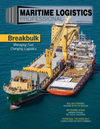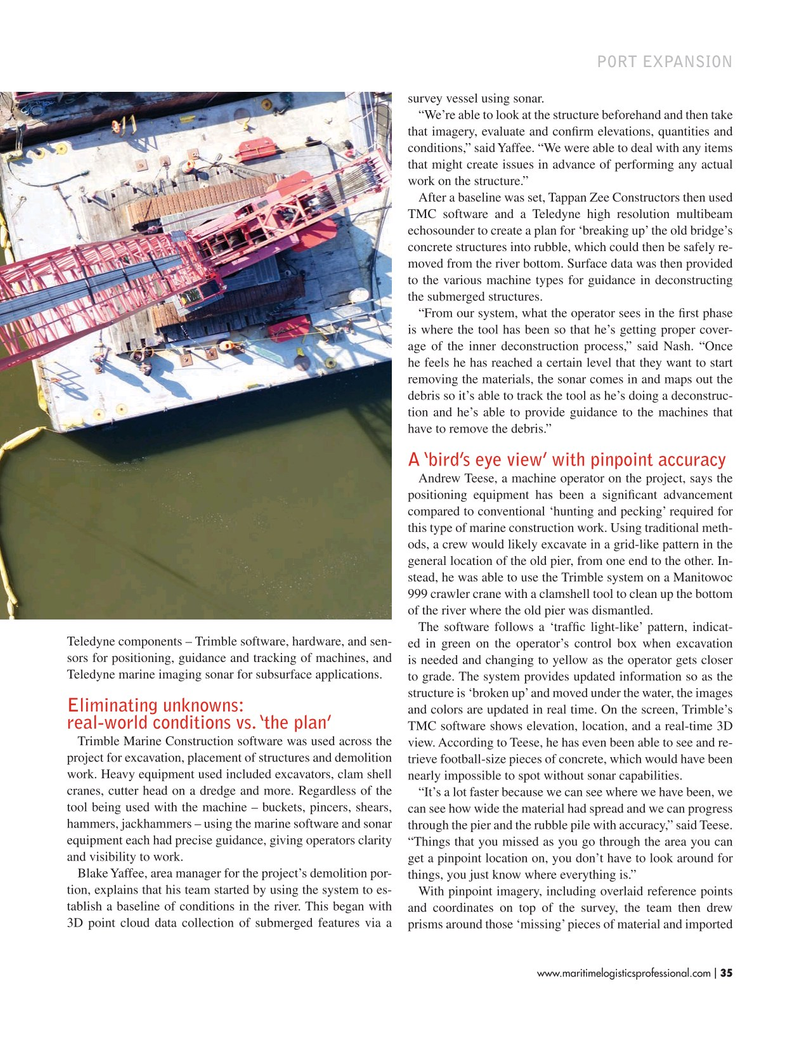
Page 35: of Maritime Logistics Professional Magazine (Jul/Aug 2019)
Breakbulk Issue
Read this page in Pdf, Flash or Html5 edition of Jul/Aug 2019 Maritime Logistics Professional Magazine
PORT EXPANSION survey vessel using sonar. “We’re able to look at the structure beforehand and then take that imagery, evaluate and con? rm elevations, quantities and conditions,” said Yaffee. “We were able to deal with any items that might create issues in advance of performing any actual work on the structure.”
After a baseline was set, Tappan Zee Constructors then used
TMC software and a Teledyne high resolution multibeam echosounder to create a plan for ‘breaking up’ the old bridge’s concrete structures into rubble, which could then be safely re- moved from the river bottom. Surface data was then provided to the various machine types for guidance in deconstructing the submerged structures. “From our system, what the operator sees in the ? rst phase is where the tool has been so that he’s getting proper cover- age of the inner deconstruction process,” said Nash. “Once he feels he has reached a certain level that they want to start removing the materials, the sonar comes in and maps out the debris so it’s able to track the tool as he’s doing a deconstruc- tion and he’s able to provide guidance to the machines that have to remove the debris.”
A ‘bird’s eye view’ with pinpoint accuracy
Andrew Teese, a machine operator on the project, says the positioning equipment has been a signi? cant advancement compared to conventional ‘hunting and pecking’ required for this type of marine construction work. Using traditional meth- ods, a crew would likely excavate in a grid-like pattern in the general location of the old pier, from one end to the other. In- stead, he was able to use the Trimble system on a Manitowoc 999 crawler crane with a clamshell tool to clean up the bottom of the river where the old pier was dismantled.
The software follows a ‘traf? c light-like’ pattern, indicat-
Teledyne components – Trimble software, hardware, and sen- ed in green on the operator’s control box when excavation sors for positioning, guidance and tracking of machines, and is needed and changing to yellow as the operator gets closer
Teledyne marine imaging sonar for subsurface applications. to grade. The system provides updated information so as the structure is ‘broken up’ and moved under the water, the images
Eliminating unknowns: and colors are updated in real time. On the screen, Trimble’s real-world conditions vs. ‘the plan’
TMC software shows elevation, location, and a real-time 3D
Trimble Marine Construction software was used across the view. According to Teese, he has even been able to see and re- project for excavation, placement of structures and demolition trieve football-size pieces of concrete, which would have been work. Heavy equipment used included excavators, clam shell nearly impossible to spot without sonar capabilities. cranes, cutter head on a dredge and more. Regardless of the “It’s a lot faster because we can see where we have been, we tool being used with the machine – buckets, pincers, shears, can see how wide the material had spread and we can progress hammers, jackhammers – using the marine software and sonar through the pier and the rubble pile with accuracy,” said Teese. equipment each had precise guidance, giving operators clarity “Things that you missed as you go through the area you can and visibility to work.
get a pinpoint location on, you don’t have to look around for
Blake Yaffee, area manager for the project’s demolition por- things, you just know where everything is.” tion, explains that his team started by using the system to es-
With pinpoint imagery, including overlaid reference points tablish a baseline of conditions in the river. This began with and coordinates on top of the survey, the team then drew 3D point cloud data collection of submerged features via a prisms around those ‘missing’ pieces of material and imported www.maritimelogisticsprofessional.com 35
I

 34
34

 36
36
